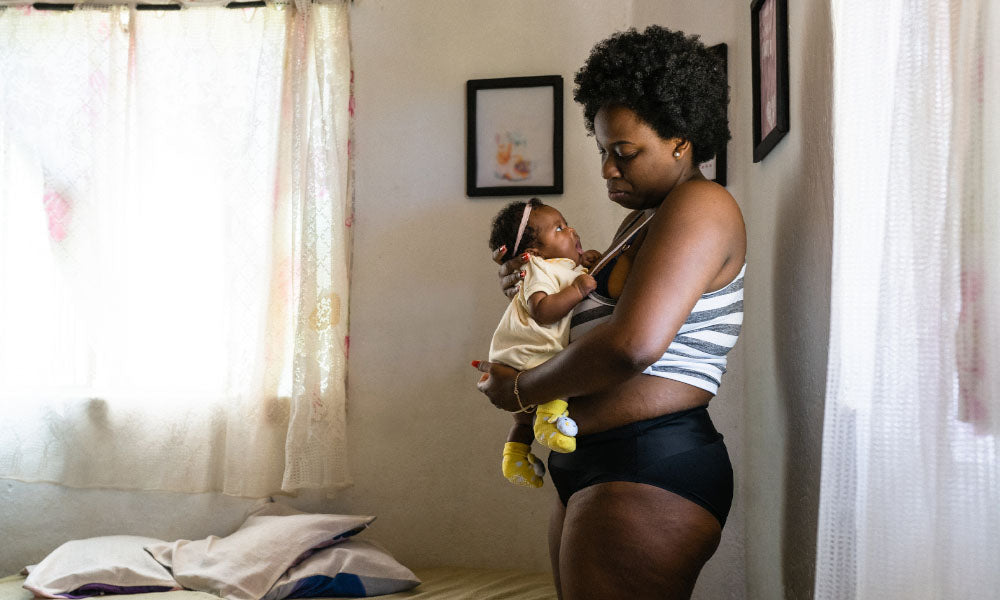It’s been two-and-a-half years since my last baby was born. While I didn’t put on a ton of weight during either of my two pregnancies, I did lose any recognizable tone in my mid-section. My breasts, which were already large, spent a combined total of 36 months nursing. They now feel like giant water balloons that need a crane to lift them.
I don’t always feel great about my body. Beyond being frustrated at not fitting into dresses or cringing when I see a photo of myself, I also feel less healthy. I worry that the weight in my mid-section is going to contribute to health problems, and I know it’s already contributing to my back pain. Lately, I’ve been feeling like I really need to do something about it, but I’ve also been feeling a bit guilty for caring because I’m committed to women’s liberation and the freedom to love your body no matter what it looks like.
I’m on my journey, just like many other women I know, and I’m learning to feel more confident in my body, while also focusing on finding ways to feel better about my health. Along the way, I’m finding strategies big and small to help me feel proud of who I am physically.
Educate Yourself about Childbirth Recovery
To expect my body to be the same as it was, or even "better" than it was, before having two children is an unreasonably high bar to set. It has helped me greatly to learn the intimate details of what happens to a woman’s body during pregnancy, childbirth, and nursing.
From the loosening of ligaments to the widening of hips to the separation of muscles, this act of childbirth is amazing and also traumatic for a woman’s body. In the short term, research has demonstrated that recovery from childbirth takes much longer than the six-week “permission to return to regular activities” mark. In fact, a study by the University of Michigan found that childbirth can result in injuries to the pelvic floor that are as traumatic to the human body as those caused by significant athletic injuries.
Researchers demonstrated that up to 15 percent of women sustain injuries that would be treated much more intensively if they were athletes. They can take eight months or longer to heal, and kegel exercises are not enough for some women. In addition, many women are never educated about diastasis recti abdominis, a condition in which the two muscles of the belly are separated from each other. This condition is still present in more than 30 percent of women up to 12 months after pregnancy. Knowing these facts made me feel much better about the limitations of my body – about how I still have pain that hasn’t been addressed and prevents me from being as active as I’d like to be.
Seek Support
Learning to be more educated and candid about the impacts of pregnancy and childbirth on my body has helped me seek out medical help and coaching that I otherwise would not have learned about. I started with a physical therapist, who helped me to identify exercises to heal my diastasis recti (and exercises to avoid until it was healed). After seeing her, I signed up for an online program called The Mutu System (short for “mummy tummy”) that provides an educational series of exercises to continue recovery from childbirth through an online learning community.
Still feeling pain, an article about pelvic floor injury made me leap at the chance to attend a workshop at a local physical therapist’s office on pelvic floor dysfunction (thanks to Evolution Yoga for their focus on women’s health). People who do this work feel strongly that every woman who gives birth should see a physical therapist with expertise in postpartum recovery, a practice that is glaringly absent in the United States.
I learned a series of exercises that I continue to do on a daily basis which have helped me to function better and move toward integrating more movement back into my life. Because I am an exhausted working mother, I know myself well enough to know that a little outside accountability would help, so I have contacted an integrative health coach to learn about working with her to design and stick to a more healthy routine. Some of these options have been more expensive than others, as they were not all covered by my health insurance. But they have all contributed to giving me a greater sense of empowerment over my well-being.
Practice Mindfulness and Acceptance
Mindfulness is the practice of being aware, non-judgmentally, of the present moment. Through meditation and the integration of mindfulness into daily living, one can learn to set aside the worries and pre-occupations that might threaten to take over. One of the best concepts I have learned in my mindfulness practice is that of acceptance.
Acceptance means being okay with what is happening and where you are in the present moment as well as the emotions that come with this moment. It does not mean that you have to love where you are or give up any notion of moving forward. This practice has worked so well for me that I am becoming a certified teacher.
My teacher training with the Koru Mindfulness Program uses the metaphor of a car stuck in the mud. You don’t have to like that you are stuck in the mud, but if you can accept that situation, you’ll figure out a much better way to get out of the mud than getting angry and sitting there spinning your wheels. When I feel frustrated with my weight or my health, I remind myself of the reason why I am here: I carried two amazing kids into this world over the last seven years; I gave birth to them, which understandably caused some damage to my body; I also nourished them for 18 months each.
My body won’t recover from that overnight, and that is more than okay. I don’t have to be 100 percent happy with my body as is, but I can accept it, while understanding what it takes to heal. These are the first steps to feeling better.



